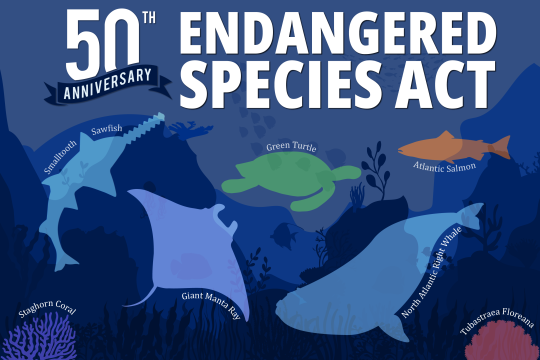Banggai Cardinalfish
Pterapogon kauderni

Protected Status
Quick Facts
 Banggai cardinalfish. Credit: NOAA Fisheries.
Banggai cardinalfish. Credit: NOAA Fisheries.
Banggai cardinalfish. Credit: NOAA Fisheries.
About the Species
 Banggai cardinalfish. Credit: NOAA Fisheries.
Banggai cardinalfish. Credit: NOAA Fisheries.
Banggai cardinalfish. Credit: NOAA Fisheries.
The Banggai cardinalfish is a small marine bony fish. The species is endemic to the Banggai Archipelago in Indonesia but has been introduced outside of its natural range through the ornamental live reef trade. The main threats to the Banggai cardinalfish are harvest for the ornamental live reef trade and habitat destruction. In 2016, NOAA Fisheries listed the species as threatened under the Endangered Species Act.
Appearance
The species is differentiated from all other cardinalfish by its tasseled first dorsal fin, elongated anal and second dorsal fin rays, and deeply forked caudal fin. It is brilliantly colored with contrasting black and light bars with whitish spots over a silvery body. The dot pattern is unique to individual fish and can be used to identify specimens. Generally, males and females look similar; however, on average, males have a larger mouth gape relative to their total body length and can be distinguished during brooding when their oral cavity becomes enlarged.
Behavior and Diet
The Banggai cardinalfish feed primarily on copepods, but it also eats planktonic organisms when they are abundant in the area.
Where They Live
The Banggai cardinalfish lives in shallow, calm waters among coral reefs and seagrass beds of the Banggai Archipelago, Indonesia.
Lifespan & Reproduction
The Banggai cardinalfish life span is approximately 2.5 to 3 years with a maximum lifespan of up to 5 years. The species possesses several unique reproductive traits. Like many cardinalfishes, sex roles are reversed, and males provide parental care, brooding and hatching eggs in their mouths. Males release fully formed juveniles.
Threats
Commercial Harvest for the Ornamental Live Reef Trade
The Banggai cardinalfish is targeted for the ornamental live reef trade due to its colorful traits.
Habitat Destruction
The Banggai cardinalfish's coral reef habitat is destroyed by the use of fish bombs (typically made with fertilizer and phosphorus) and cyanide to catch fish for the live reef fish trade. Runoff from agriculture and human population growth, increase waste and nitrates in the marine environment, promoting algal blooms, which the light and oxygen available for corals.
Scientific Classification
| Kingdom | Animalia | Phylum | Chordata | Class | Actinopterygii | Order | Perciformes | Family | Apogonidae | Genus | Pterapogon | Species | kauderni |
|---|
Last updated by NOAA Fisheries on 10/18/2023
Featured News

The Endangered Species Act: 50 Years of Conserving Species
Management Overview
The Banggai cardinalfish is listed as threatened under the Endangered Species Act
Regulatory History
In 2013, NOAA Fisheries received a petition to list the Banggai cardinalfish as threatened or endangered under the Endangered Species Act. In our 90-day finding, we concluded that the petitioned action may be warranted. After completing a status review, we proposed to list the species as threatened and requested comments from the public. In 2016, NOAA Fisheries listed the Banggai cardinalfish as threatened under the Endangered Species Act.
Key Actions and Documents
More Information
Last updated by NOAA Fisheries on 10/18/2023
Documents
Banggai Cardinalfish 5-Year Review
This document is the ESA 5-year review of the species based on the best available data.
Status Review for Banggai Cardinalfish, Pterapogon kauderni
This report is the status review for the Banggai cardinalfish. This report summarizes the best…
Last updated by NOAA Fisheries on 10/18/2023